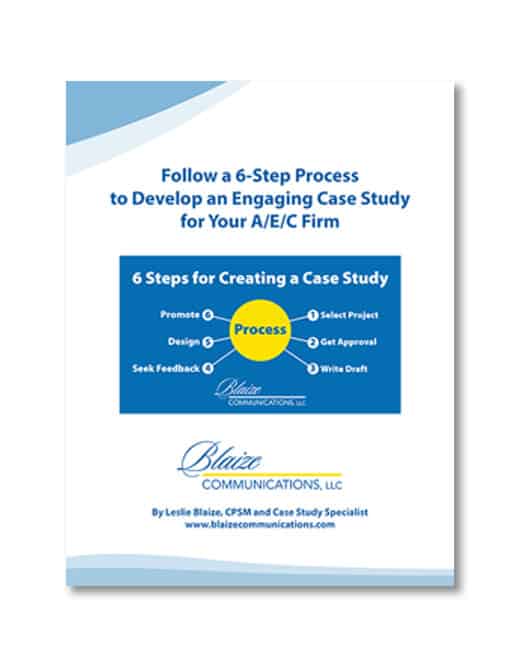How will AI impact the creation of case studies for the Architecture/Engineering/Construction industry?
It can help, but writers will still play an essential role in telling a firm’s client success stories.
“It’s the larger, more complex writing project where AI copywriting software can’t replace human writers,” says A-level copywriter and AI writing expert Guillermo Rubio.
He emphasizes that AI can create short-copy projects like ads and product descriptions. However, what it can’t do is “tell an emotionally compelling story,” Rubio says.
When I started my freelance writing business, I wrote product descriptions regarding chandeliers and other products for the lighting industry. Now that company may use AI to write those descriptions with some human oversight.
Client-focused case studies, however, are a different story. AI can be a partner, waiting to help with some components. But it can’t perform many essential tasks that require the human touch.
Case Studies Need Human Interaction
Many of the critical steps of case study development depend on personal interactions. Check out the following steps that are necessary to craft an engaging case study.
Select a Happy Client
Once an A/E/C firm knows its strategic goal for a case study, the next step is to ask a happy client if they’ll participate. Typically, a firm’s contact who knows the client best will make the request. An established personal relationship matters.
The happy client will learn that their commitment will be to take part in a 30- to 45-minute interview and then approve a draft copy. They’ll receive free publicity and help prospects who want to know more about a firm.
Interview the Happy Client
One of the most critical aspects of writing a client success story is interviewing the happy client. The best approach is a one-on-one interview between the writer and the client. I typically share my questions with the A/E/C company and then the happy client to reduce concerns about the interview process.
A writer’s job is to connect with the client on an emotional level to establish rapport. During the interview, the client will respond to the designated questions. But the real magic occurs with follow-up questions. A client may provide unexpected answers, illustrating a firm’s value during a project.
Write Copy Reflecting the Firm’s Brand
From the start, a case study writer should understand how the firm’s expertise helped a client achieve their goals. How does the project reflect that company’s brand and mission?
When interviewing the client, the writer can ask questions showing how a company lived up to its brand. As part of the narrative, the writer can weave in comments from a company representative to highlight the firm’s differentiators.
Humanize the Content
AI content is typically bland and factual. To add interest, case studies often include stories and quotes that reflect a project’s challenges and solutions.
A success story describes a client’s dilemma. What situation did they face, and how did they feel? How did a project solution make a difference? Did an A/E/C company add extra value that saved the client time and money?
Readers — especially prospects — want to know what it’s like to work with a company. A happy client’s personal experience is very valuable for prospects. It can help reassure them that the A/E/C firm would be a reliable partner for their future project.
How AI Can Help With Case Study Creation
The good news is that writers can collaborate with AI to create even more compelling case studies. This help can begin before an interview and continue through the writing and editing process. However, you have to be wary of AI’s faults. Information can be inaccurate, and writers should translate content into their own words.
Identify Prospect’s Challenges
As the case study writer, you’ve been informed about the happy client you’ll interview, the selected project, and the firm’s strategic goals for the narrative.
Now what? An excellent place to start is to understand the potential pain points, challenges, and goals of the happy client and prospects. Ask ChatGPT or another AI platform to provide some insights.
In my prompt, I’ll ask ChatGPT to write a diary entry from a prospect that reveals their concerns about a specific project. My goal is to give AI the most context possible, such as the title of my prospect, the designated industry, and project type.
Using the described persona of an A/E/C prospect, I’ll ask AI to tell me what worries this individual the most about a potential project and what’s important to them when selecting an A/E/C firm.
Those insights will help me craft the appropriate questions for the interview and emphasize key points when writing the case study.
Create an Outline
Writers appreciate that they no longer have to look at a blank page before writing content. You can ask AI to develop an outline or summarize a transcript of your interview with the happy client.
Through AI, I have a place to start with my content if needed. I also may ask it to research specific points. Any facts or statements would need to be verified.
Edit Content
After you complete a draft, you can use an AI platform to edit it. I turn to Grammarly, an AI writing assistant, to check for grammar, spelling, and style improvements. Other platforms include ProWritingAid and Hemingway Editor.
I’ve also used ChatGPT to review my case study. For the most part, its output isn’t too helpful. However, I sometimes get ideas for more efficient word choices or a better summary of a critical idea.
Recommend Headlines
When I start writing a case study, I create a basic headline. Then, when I have a near-final draft, I share it with ChatGPT and ask it to suggest some headline ideas. I appreciate this feature. AI helps me to create more effective headlines in a fraction of the time it used to take me.
I’ll ask AI to give me 10 or 15 headlines to start. I may ask it to “keep going” if I’m not satisfied. Then I’ll merge portions of one or two headlines or create something else based on these ideas. Sometimes I ask AI to judge two headlines and recommend which is better for my target audience.
Collaborating With AI
Like many other writers, I’m experimenting with AI to see how it can help me create case studies to benefit my clients. I know I’ve just scratched the surface, and there’s a lot more to learn.
When I use ChatGPT, it’s like going on an adventure. Some twists on the path will be dead ends, and it may take a lot of work to reach my goal. But at other times, my AI partner directs me to a surprising shortcut or new vistas that I wouldn’t have found on my own. AI may offer a different word choice or a relevant concept I should have considered.
Creating engaging case studies for the Architecture/Engineering/Construction industry requires the human touch. However, AI can play an important support role if used correctly.
Want to Know More About Case Studies?
Subscribe to A/E/C Connect LinkedIn Newsletter if you’re interested in learning more.
If you have a challenge or question you would like me to address, please contact me online or email blaizecommunications@gmail.com.



